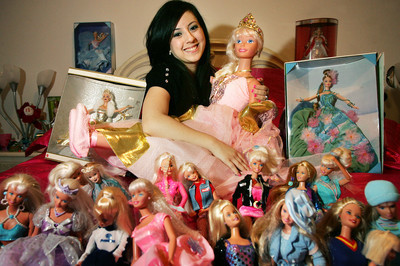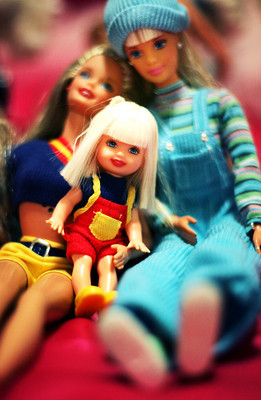Teen loves big Barbie collection as doll celebrates 50 years
Marcella Velcre and Ariel Akhobadze are, like, BFFs and totally inseparable.
But no matter how close the 16-year-olds are and no matter what the best friends forever share, Akhobadze will never understand Velcre's Barbie collection.
She can't even stand to be around them.
"Oh yeah, I hate going in her house and sitting in her room," Akhobadze says. "Sleepovers are usually at my house because I can't sleep in her room. Not with all those eyes staring at me. It's creepy."
Whatever, Velcre responds. Her 30-plus Barbie dolls are treasures. To her.
"It's not like they're porcelain dolls," Velcre says. "Now those are creepy."
But Velcre is used to that kind of response to Barbie. People either love the doll or they hate it, she says.
In fact, Barbie has evoked those exact responses since she was introduced during the annual Toy Fair in New York on March 9, 1959, says Liz Grampp, director of marketing for Barbie Collector, a division of Mattel. This year marks Barbie's 50th anniversary.
"When you mention Barbie or talk about Barbie, she elicits a reaction. People definitely have an opinion," Grampp says.
Some people hate the doll because they think it doesn't provide young girls with a positive role model or realistic body image. Others love her, Grampp says, because girls can live out a fantasy of being an astronaut, a Dallas Cowboys cheerleader, a Malibu beachcomber, a presidential candidate or even a waitress.
Negative opinions aside, Barbie is more popular today than ever, Grampp says, especially with collectors.
Collecting exploded in the early 1990s, with adults making up the majority of collectors. A Web site, barbiecollector.com, was launched in the late 1990s. People can join an official fan club, and thousands attend an annual Barbie convention.
A reluctant collector at first, Velcre received her first Barbie -- she doesn't recall which one -- when she was about 3. All of her dolls are gifts from her grandmother, who has showered her with Barbies throughout her life, giving her a doll for birthdays, holidays, even putting one in her Easter baskets.
Though her first inclination was to "de-box" those Barbies and play with them, Velcre's parents and grandmother encouraged her to keep them in the boxes, and thus in pristine condition.
De-boxers and "Never Removed From Box" collectors are the two main types of collectors. De-boxers want Barbie to live a free life, Grampp says, while NRFBers insist the dolls must remain in their packaging. Or else.
Most of Velcre's Barbies are untouched, kept away from grubby little child hands and child inclinations to do things such as cut Barbie's hair, remove Barbie's head, make Barbie crash her tiny pink convertible and lose a limb. Ken, Barbie's longtime suitor, wasn't so lucky. Velcre gave him a haircut, thinking it would grow back. It didn't, so Ken had to die.
"My family wanted me to collect Barbie. They still want me to collect them. I'm actually supposed to be getting a glass thing to put them in," Velcre says. "When I was younger, I wanted to play with them. As the years progressed, I wanted to keep them in the box. It was like, 'Oh, it's so cool to see them in the box.'"
There was a time when Velcre lived and breathed Barbie. She tooled around her house in a motorized pink Barbie convertible until she was too big to fit in it; when she brushed her hair, Velcre sat at a Barbie vanity that had a tiny seat for one of her dolls she was allowed to play with. She had to brush Barbie's hair, though.
There was the Malibu beach house, the cool one that was split in half and opened up.
And then there is My Size Barbie. Standing 3 feet tall and wearing a dress that Velcre often tried on when she was a kid, the My Size Barbie is one of her favorites.
Akhobadze does not approve, calling it Velcre's life-size Barbie. "It sits at the foot of her bed and it's super creepy," Akhobadze says.
She doesn't hold her feelings back from Velcre. They're BFFs, so they have to be honest with each other. That means telling the truth when one of them asks, "How does this outfit look on me?" or "What do you think of my Barbie collection?"
"They're kind of weird, they sit in boxes and they kind of stare at you," says Akhobadze, who never liked Barbie, preferring G.I. Joe, instead. "We kind of laugh about it, it's kind of an inside joke."
Velcre doesn't discuss her Barbies with her other friends because she knows they don't really like them. Their feelings don't faze her; she's the one who's going to have the collection worth a lot of money, one day. She hopes.
"If my friends come to my house they think, 'Wow, you're weird, you have Barbies in your room.' I don't care, I've had these my whole life," Velcre says. "To me, it's like they have value because it's something I've had since I was little. My parents told me one day I would appreciate them when I was older. They mean a lot to me."
Contact reporter Sonya Padgett at spadgett @reviewjournal.com or 702-380-4564.
FOREVER THE FASHION MAVEN
Though Barbie is turning 50, she doesn't look like a woman who has lived half a century.
"We normally say she's forever a teenage fashion model," says Liz Grampp, director of marketing for Barbie Collector, a division of Mattel.
If the toy company had to put a number to her, Mattel says she's around 18 years old. She stands 111/2 inches tall and weighs 7.25 ounces.
Mattel doesn't release human-equivalent measurements of Barbie because, a spokeswoman says, "She's a doll."
However, a 1998 study extrapolated Barbie's measurements to be 39-21-33, what many detractors called unattainable for a woman.
Barbie has experimented with more than 100 careers, even though she's just a doll, including president, surgeon and astronaut.
The doll's design has changed over the years, but its cultural relevance remains, Grampp says. No matter what time period you pick, Barbie represents the culture of that era, especially what was going on in beauty and fashion.
In 1959, the American standard of beauty was Marilyn Monroe, Grampp says. A Barbie from that era emulates that look. In the 2000s, actress Jennifer Garner's physique is considered ideal so Barbie has been leaner and more athletic.
LAS VEGAS REVIEW-JOURNAL





























